Tina's Herbal Kitchen Recipes
There are many herbs to work with in making and formulating recipes. Furthermore, I imagine there are stronger or more optimal herbs to be included in many of the recipes that you see in this section of herbal recipes on this website. I am working with the plants that grow around me or that I can easily cultivate where I live. I do not claim to be an authority on herbs or in making herbal preparations. I simply feel inspired to share my experiences and relationships with some of the plants through the years and the many benefits the world of herbs has offered to me, my family, and friends near and far. These recipes are meant to inspire you to begin your own herbal journey of experimentation, trust, and healing with the plants that grow around you.
Purple Coneflower (Echinacea purpurea, pallida, angustifolia)
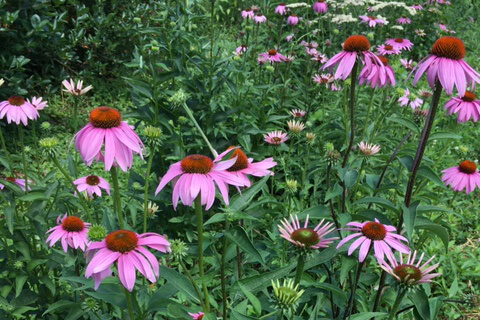
Echinacea purpurea
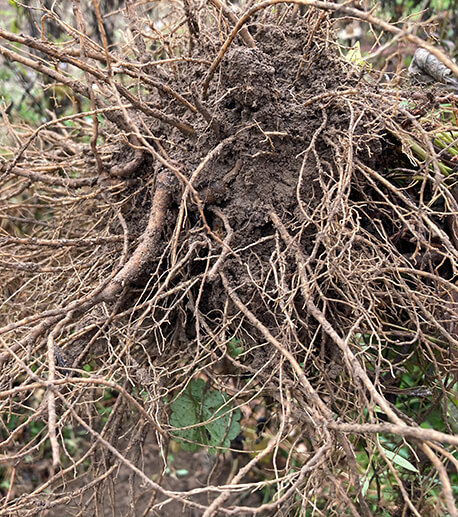
Echinacea Root
All Seasons Herbal Tea Blend
We prepare and blend herbs that we grow to be enjoyed throughout the seasons. These seasonal blends may vary depending on what herbs are available and what we may like. The all-season herbal blend that we drink often includes a mixture of Holy basil, milky Oat tops, Calendula and Elderberries, as these are some of the herbs that we tend to cultivate easily in our area and enjoy.
I suggest working with the herbs that you like and that grow around you; and experiment with combinations that you and your family enjoys. We usually start with a base blend of about three to four herbs at a time. You may want to make a tea of each of these herbs separately and then begin creating your blend. We add or omit different herbs as needed to individual cups of tea, such as one teaspoon of Sage or Monarda sp. to the seasonal blend to help with opening the nasal passages. For a sore throat we might add thyme and/or a decoction of licorice root. There are so many great herbal options to consider!
Ingredients:1 part dried Elderberries
1 part dried Holy Basil leaves
1 part dried Calendula flowers
1 part Milky Oat Tops or Comfrey leaves and stems
Option #1 : Add or replace one part dried Thyme, Common Sage, Monarda sp, or Hyssop (for sinus and throat care)
Option #2 : Add one part Echinacea root and flowers, (at onset of flu symptoms) Option #3 : Add fresh slices of Ginger (especially if feeling chilled)
Method:
1. Harvest and dry herbs or purchase them from a reputable grower.
2. Mix herbs. Place one teaspoon to one tablespoon of herbal blend in a teacup. Pour boiling water over herbs. Cover and let herbal mixture steep for 30 minutes. Strain and drink up to 3-4 x /day if needed or to simply slow down and savor tea time! 3. Compost the spent herb.
Autumn Immune Tea
This is a beautiful and colorful blend of roots, flowers, berries and leaves that can be harvested throughout late summer and into fall to make a delicious herbal blend to sip on cool Fall days as the weather changes. (This tea can be enjoyed all year too; perhaps a new name is in order).
Ingredients:1 part Echinacea flower and roots
1 part Calendula flowers (Calendula officinalis)
2 parts Holy Basil (Ocimum sanctum)
Optional: Fresh Ginger slices to taste
Filtered boiling water
Raw, local honey to taste (if desired)
Method:
1. Harvest and dry herbs or purchase them from a reputable grower.
2. Mix herbs. Place one teaspoon to one tablespoon of herbal blend in a teacup. Pour boiling water over herbs. Cover and let herbal mixture steep for 30 minutes. Strain and drink up to 3-4 x /day if needed or to simply enjoy the flavors and healing effects. 3. Compost the spent herb.
We enjoy this tea hot with or without a spoonful of raw and local honey, drinking several cups a day throughout the fall and winter when we feel the first sign of infection coming on (that feeling of exhaustion and fatigue). We often incorporate some Elderberry syrup to the tea during an illness. Once the illness subsides, we take a break from drinking this herbal tea blend and enjoy the many other herbs that are available to us.
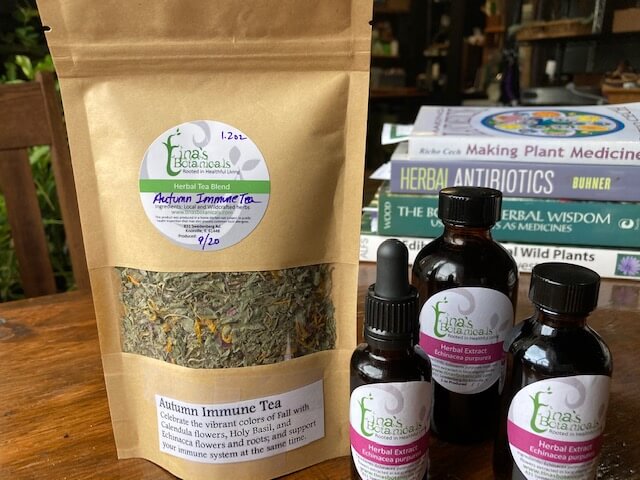
Echinacea tea blend and Echinacea tincture
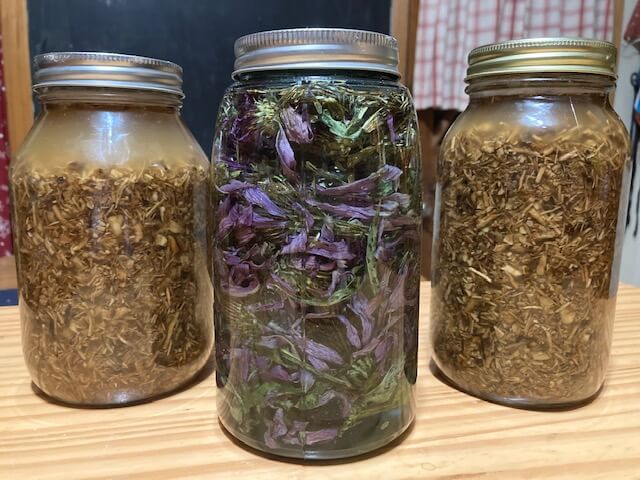
Making Echinacea tincture
Whole Plant Echinacea Tincture
A tincture is a highly concentrated liquid herbal extract usually made with alcohol and water as the solvent (and sometimes glycerine). This method of preservation makes a convenient way to dispense the herb and preserve the herb for longer periods of time. Tinctures may be used externally and internally in small amounts and are often dispensed in water. This method uses a traditional folk method and can be done quite easily in your own kitchen or garden without a lot of fancy equipment or precise measurements.
Ingredients:Fresh Echinacea flowers, leaves, roots (Dried root can be used)
80-100 proof vodka or brandy (or grain alcohol of choice and preferably organic)
Clean jars, scissors or knife, strainer and labels
Method:
1. Harvest the Echinacea flowers and leaves in summer when blooming. Dig roots in Fall.
2. Clean and Chop in small pieces, using durable scissors or a knife to cut the aerial parts or roots of the Echinacea and place in a clean jar to fill it approximately 2/3-3/4 full.
3. Pour alcohol of choice over the Echinacea herb and stir to ensure all of the herb is immersed, covering the herb by two inches with the alcohol. Seal the jar with a tight fitting lid.
4. Label jar with contents and date. Place the jar in a warm location for four to six weeks so that herbs macerate. Swirl solution daily, infusing it with healing and positive energy.
5. Strain solution after the allotted time by pouring the macerated mixture through a strainer into a clean jar so that the solution is separated from the herbs and a clear solution remains. (I often use a metal funnel under the stainless steel strainer for support, and maybe a designated tea towel placed inside the strainer). Squeeze out the herbs so that you get all the medicinal constituents from the herbal infusion. Ideally, a d ark colored jar is used to store the newly made tincture. Label the jar with the contents and date and then store in a cool and dark place. Some of the solution can be poured in smaller amber jars for use later. Alcohol based tinctures should last for several years.
For more information on which herbs are best suited for this method, which herbs are better extracted fresh or dry, and how to measure the strength in grams and milliliters, consult Tina for an herbal educational workshop on making liquid extracts or tinctures.
Echinacea Throat Spray or Mouthwash
This spray is a mixture of a tincture, an infusion, and honey. Sprays made with tinctures may be used as healing remedies for external and internal application in small amounts and sometimes mixed with other herbal infusions. This spray may be used on a sore or scratchy throat.
Ingredients:1 part Echinacea tincture
1/2 part Tea of Monarda fistulosa (1-2 tsp flowers steeped in 1/2 cup filtered water)
1/2 part raw local honey (do not need honey, if making this as a mouthwash)
Optional: 1-2 drops of sweet orange or essential peppermint oil
Clean spray bottle (2 oz )
Method:
1. Make a tea with 1 -2 teaspoon of Monarda fistulosa flowers in 1/2 cup boiled water and steeped for 15 minutes. Sage or Thyme could also work here if you do not have Monarda.
2. Mix 1 part Echinacea tincture (2 oz or 1/4 cup is a good place to start) with 1 oz or 1/8 cup of Monarda tea and and 1 oz or 1/8 cup of of honey in a 2-4 oz amber glass spray bottle.
3. Add 1-2 drops of desired essential oil if you would like the solution to be tastier.
4. Label the jar with the contents and date and then store in a cool and dark place, the refrigerator is ideal.
5. Use this with a sore throat by spraying into the back part of the mouth so that the throat receives the application directly. This can be sprayed 1-2 x an hour throughout the day.
Echinacea-Yarrow - Comfrey Herbal Liniment or First Aid Spray (for External Use)
Herbal liniments are topical remedies that are rubbed onto the skin. They are made in a similar manner as a tincture, often using alcohol, vinegar, oil, or witch hazel. Liniments can easily be made in our kitchens or gardens without fancy and expensive equipment. Liniments are often used as a counter irritant, for pain from sore muscles and ligaments and to disinfect wounds. We have used this liniment as a first aid spray for minor skin irritations, inflammation, and animal bites and stings.
Ingredients:1 part Echinacea flowers, leaves, and roots (fresh or dry)
1 part Comfrey leaves, stems, and/or root (freshly picked and wilted for 24 hours) 1 part Calendula flowers (freshly wilted)
1 part Yarrow flowers and leaves (freshly harvested after the dew has dried)
Another herb to consider including is Barberry root if it is growing in your area.
1/2 part 1/4 - 1/8 Cayenne pieces or flakes (dried)
Rubbing alcohol, Vodka, or vinegar
Method:
1. Harvest and clean the herbs. Dry or wilt the herbs as needed.
2. Chop or cut the herbs very finely and place in a clean and dry jar. Pour alcohol or vinegar to cover the herbs by two inches. Secure the lid on the jar and let sit in a warm location 4-6 weeks.
3. Strain the herbs after the allotted time period and pour into a clean jar or spray bottle.
4. Label and store in a cool and dark place. To use the liniment, pour a small amount into hand (or spray onto desired area). Gently rub and massage the liniment towards the heart, using long and steady strokes. A compress can be made with the liniment by soaking a clean cotton cloth and applying it directly onto the desired area. If the liniment bothers the skin, try making the same recipe infusing the herbs in oil.
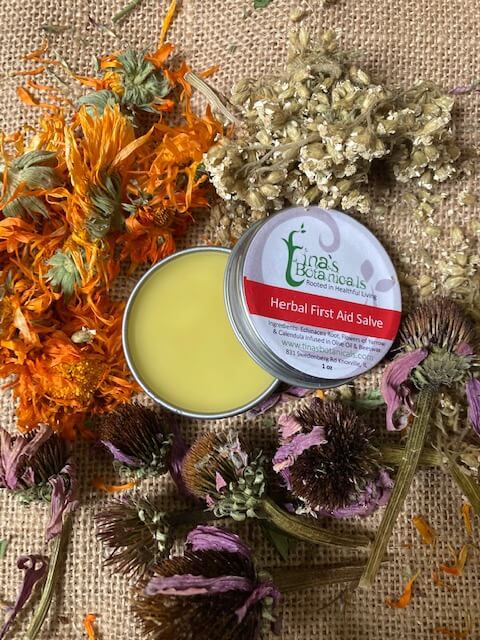
Echinacea salve
Echinacea -Yarrow - Calendula Herbal First Aid Salve
After returning from a trip to the UK in 2017 with my family, and learning about even more ways in which different people have worked with herbs for hundreds of years, I was excited to return home to continue my ongoing herbal studies with inspiration and ideas of experimentation. My interest is in working with the plants that grow around me, where I live in mid-western Illinois, and incorporating the many lessons learned from what others have done and are doing so that perhaps new connections are explored in ways that are accessible and helpful. Because I enjoy creating all sorts of herbal salves with these familiar plants that grow in my midst, I experimented with infusing the aerial parts of Yarrow and Echinacea in organic olive oil (each of them separately) with the plan to combine them together with Calendula infused oil to make a salve. I have been happy with the results and have found this blend to be beneficial for skin irritations such as cuts, scrapes, animal bites and stings, as well as lending an antiseptic quality and assisting in relief of inflammation and pain.
Ingredients:1/3 c Echinacea infused organic olive oil (made with freshly wilted flowers, leaves, and root)
1/3 c Yarrow flowers and leaves infused in organic olive oil (freshly wilted)
1/3 c Calendula blossoms infused organic olive or oil of choice (freshly wilted) Good quality Beeswax, cleaned and grated
Method:
1. Prepare an herb infused oil of each herb separately. Strain after 6 weeks. See recipe for making herbal oils under Calendula Herbal Recipe
2. To make the salve: Blend the different infused oils in a 500ml pyrex glass measuring container or a 1 pint heat proof jar.
3. Add 1/4 cup grated beeswax to the mixed oils in the 500 ml pyrex measuring container or jar, place in a pot of gently boiling water or a double boiler to melt the beeswax.
4. When beeswax is melted, remove the glass measuring container from the hot water and pour into small jars or tins. It will thicken and harden as it cools. If the consistency is not to your liking, simply remelt salve and make adjustments (more beeswax for a firmer salve or more oil for a softer salve).
5. Apply lids with labels that include ingredients and date to each slave container. This makes approximately eight ounces of salve.
6. How to use this salve: Apply a small amount of salve to a small area to ensure this particular herbal salve works with you and serves you in the way you need it.
Yarrow (Achillea millifolia)
Yarrow Cold and Fever Herbal Tea Blend
This combination of herbs has been used for a long time. I first read about this tea in A Modern Herbal, by Mrs. Maude Grieves, which was first published in 1931. Interestingly, I had already been making a similar blend on my own for its relief of fevers and colds for myself and my family. This is a delicious healing remedy to include in your herbal medicine chest to be taken at the onset of a cold and fever, helping to open the pores, especially with obstructed perspiration.Ingredients:
1 part Yarrow flowers and leaves
1 part Elder flowers
1 part Peppermint leaves
Method: Make a strong infusion of the herbal tea by pouring a pint of boiling filtered water over one - two Tablespoons of the herbal blend, depending on your preference. Steep the tea blend for 15 minutes and strain. Drink the hot tea with or without honey, allowing the herbs to begin to do their work. If the fever persists, drink another cup of tea in 30 minutes to an hour. Continue to drink a cup of tea every 30 minutes to an hour, until the fever breaks.
Yarrow First Aid Spray
This spray is like making a tincture, which is a highly concentrated liquid herbal extract. Tinctures are often used as healing remedies and used externally and internally in small amounts, usually taken in water or tea. This method uses the traditional simpler's method and can be done quite easily in your own kitchen or garden without a lot of fancy equipment or precise measurements. This spray is one of our favorite items in our First Aid kit. We use it for an assortment of cuts, scrapes, and wounds, helping to stop the bleeding, disinfect the area and provide pain relief. We have also found Yarrow spray to be helpful as a natural and safe insect repellent, as well.Ingredients:
Fresh Yarrow flowers and leaves
80-100 proof vodka or brandy (or alcohol of choice)
Clean jars, scissors or knife, strainer and labels
Methods: Gather Yarrow flowers and leaves after the dew has dried and preferably after 3 days without rain. Chop finely or use scissors to cut the Yarrow leaves and flowers and place in clean jar. Pour alcohol of choice over the Yarrow herb and stir to ensure all of the herb is immersed, covering the herb by two inches with the alcohol. Seal the jar with a tight fitting lid. Label jar with contents and date. Place the jar in a warm location for four to six weeks so that herbs macerate. Swirl solution daily, infusing it with healing and positive energy. After the allotted time, pour the macerated mixture through a strainer into a clean jar so that the solution is separated from the herbs and a clear solution remains. (I often use a funnel, for support, with the strainer set inside it and maybe an old tea towel). Squeeze out the herbs so that you get all the medicine from the infusion. Ideally, a dark colored jar is used to store the newly made tincture/spray. Label the jar with the contents and date and then store in a cool and dark place. An alcohol based tincture should last for several years. We pour this solution into a 4 ounce amber spray bottle and label it as a Yarrow First Aid spray, and keep it in our first aid kit and accessible in the kitchen.
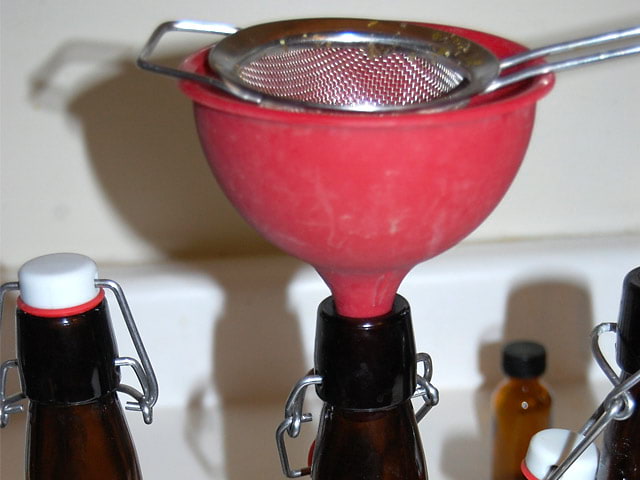
Yarrow - Comfrey Herbal Salve
The use of Yarrow in a salve was mentioned to me on a recent trip to Scotland with my family, as I asked questions about the various familiar herbs that I identified in the fields and roadsides. It was said by our tour guide that Yarrow was used in an ointment by the Highlanders for all sorts of issues with distended veins and capillaries, including piles (or hemorrhoids) and it is/was used as a general disinfectant salve. I came home immediately and infused Yarrow in oil to make such a salve, including Comfrey in it, for its healing qualities, as well.Ingredients:
Yarrow flowers, leaves and stems (freshly wilted or dried)
Comfrey leaves and stems (freshly wilted or dried)
Organic oil of choice (olive, almond, apricot, grapeseed)
Good quality Beeswax
Method: Prepare an herb infused oil. See Herbal Recipes under Comfrey Infused Oil for how to make the Yarrow infused oil. 1/2 cup Yarrow flowers and leaves infused in oil for 4-6 weeks (strained) 1/2 cup Comfrey leaves and stems infused in oil for 4-6 weeks (strained) 1/4 cup Clean Grated Beeswax (use more if you like a very firm salve) Optional: add 1/2 teaspoon Vitamin E oil as additional preservative
Yarrow - Comfrey Herbal Liniment (for External Use)
Herbal liniments are external remedies that are rubbed into the skin. They are made in a similar manner as a tincture. Liniments are often used to soothe sore muscles and ligaments and disinfect wounds. This liniment is helpful for treating varicose veins and bruises, with its astringent action which tightens and firms blood vessels and clears blood congestion. It is made in the traditional simpler's method (where exact measurements are not strictly followed and fancy equipment is not required).Ingredients:
2 parts Yarrow flowers and leaves (freshly harvested after the dew has dried)
1 part Comfrey leaves, stems, and/or root (freshly picked and wilted)
1/2 part Raspberry leaves
1/4 - 1/8 Cayenne pieces or flakes (dried)
Organic apple cider vinegar (unpasteurized)
Method: Chop or cut the herbs and place in a clean and dry jar. Pour vinegar to cover the herbs by two inches. Secure the lid on the jar and let sit in a warm location 4-6 weeks. Strain after the allotted time period into clean jar or spray bottle. Label and store in a cool and dark place. To use the liniment, pour a small amount into hand (or spray onto desired area). Gently rub and massage the liniment towards the heart, using long and steady strokes. A compress can be made with the liniment by soaking a clean cotton cloth and applying it directly onto the desired area. If the liniment bothers the skin, try making the same recipe infusing the herbs in oil.
Calendula (Calendula officinalis)
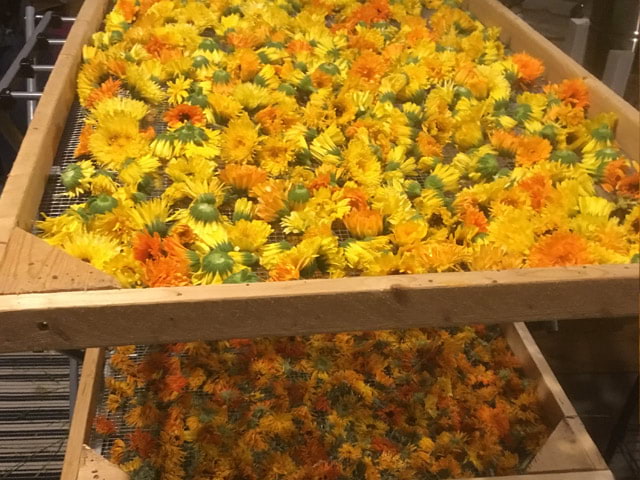
Calendula Infused Oil
Calendula infused oil promotes the healing of many skin disorders. It effectively treats burns, hard to heal wounds, varicose veins, cradle cap and damaged tissue. It is soothing to painful skin irritations and can even be used with good results for fungal and viral complications. It is also nice as a massage oil for the breasts, and in other areas with lymphatic congestion, as Calendula is a great ally to the lymphatic system. I have also used it with good results for cracked nipples after breastfeeding and for some people with eczema and other chronic skin irritations. This oil is also a nice addition to lotions and facial creams.Apply a small amount of Calendula oil and massage gently into affected area.
Ingredients:
Organic oil of choice (olive, almond, apricot, etc)
Freshly picked Calendula blossoms (wilted)
(Dried Calendula flowers can be used if freshly wilted flowers are not available)
Method #1: On a sunny day, after all dew has dried, hand pick Calendula flowers. Harvesting can be done every two-three days during the summer months, helping to promote new growth.
Spread flowers on drying screens to wilt/dry (24 hours- 4 days), as they are quite moist and may mold if you do not dry them a little before infusing them in oil. (Using a dehumidifier and fan and/or heater to help circulate air will greatly aid this drying process).
Place dried flowers in a clean jar with organic olive oil to completely cover (having a 1/4 inch of oil covering herb on top). You can crumble the flowers as you put them in jar or cut with scissors to allow more surface area exposure. Allow a little room at top of jar and check after 12 hours to see if you need to top off the oil a little (making sure all flowers are immersed in oil). Store in dark place or place in brown paper bag. Try to swirl the Calendula oil daily, infusing positive energy. Sometimes oil will seep out of the top of the jar during the infusing process, so place jar on newspaper or in a place where the oil will not drip down and create an oily mess.
After 4-6 weeks, strain Calendula flowers from oil. Let strained oil sit for one day and check to make sure there is no water present at bottom of jar. Decant the oil from the water if water separates and is present at bottom of jar so that no water is in your final product of infused oil. Label final product with Calendula, type of oil used and date.
Method #2: Use an old crock pot with a low setting. Place chopped Calendula flowers in oil so that flowers are completely covered. Heat oil on lowest setting in crock pot for 4 - 8 hours (be sure to keep temperature below 110- 120 degrees F, so as not to fry the flowers). Strain the flowers, pressing as much of the oil from the flowers as is possible. Consider using a thermometer to monitor the temperature of the oil, as oil will lose its healing properties if heated above 110- 120 degrees. Let strained oil sit for one day and check to make sure there is no water present at bottom of jar. Decant the oil from the water if it is present at bottom of jar. Label final product with Calendula, type of oil used and date.
Storage: Store the infused oil in a cool, dark place. It should be good for one year. Always smell the oils to ensure they are in their optimal state. If a rancid odor is observed, then sadly the oil will need to be discarded.
Enjoy oil as a healing remedy on its own or include it in with other infused oils and/or with beeswax for a healing salve.
Other ideas: Some other infused to consider making as healing remedies are: Plantain, Comfrey, Chickweed, Jewelweed, Lavender, Echinacea, Goldenseal, Saint John's Wort, Mullein, Bee Balm, Elder flower and Garlic, among others. I suggest making infused oils with one herb at a time. Once you have your single infused oils, other blends can be made from these single infusions.
Calendula Salve
Calendula salve is very soothing and healing to skin irritations, burns, rashes, eruptive skin disorders. It can also be used on a wound before adding a compress and/ or fomentation to help soften the skin, making it easier to penetrate wounded area with the healing herbal properties of the salve and poultice. Apply a small amount and massage gently into affected area. This is a must have for the herbal first aid kit!Ingredients:
1 cup or 8 oz Calendula flower infused oil (see above recipe)
1/4 cup or 2 oz Clean Grated Beeswax (use more if you like a very firm salve)
Optional: add 1/2 teaspoon Vitamin E oil as additional preservative
First, prepare an herb infused oil.
To make the salve, add 1/4 cup grated bees wax to double boiler. If using pyrex or mason jar, place in pot of gently boiling water to melt. Meanwhile, pour in one cup of Calendula infused oil to heat proof jar, 2-cup measuring pyrex container or double boiler with beeswax. When beeswax is melted, remove jar of solution from heat and pour into small jars or tins. It will thicken and harden as it cools. If the consistency is not to your liking, simply remelt salve and make adjustments (more beeswax for a firmer salve or more oil for a softer salve).
You can use any combination of herbal infused oils to make salves, depending on what your intention is for its use. Some other infused oils to consider blending into your healing remedies are: Plantain, Comfrey, Chickweed, Jewelweed, Lavender, Echinacea, Goldenseal, Saint John's Wort, Mullein, Bee balm and Elder flower.
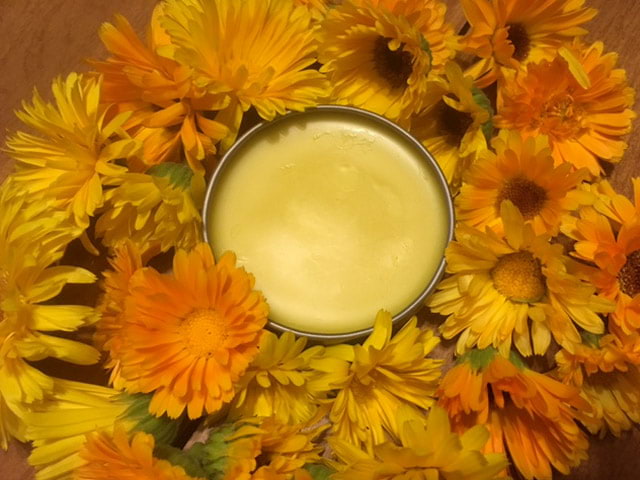
Calendula Salve
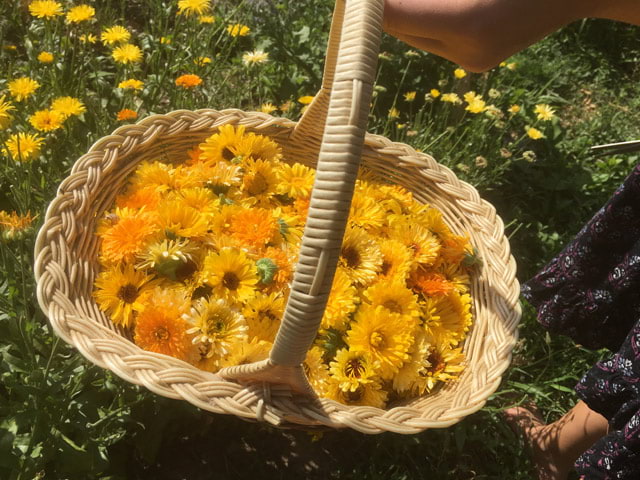
Calendula Compress or Fomentation
This is an external application of herbs to help soothe pain, alleviate inflammation, stop bleeding, treat burns and skin irritations, rashes and lymphatic congestion. Hot fomentations or compresses can help to stimulate the circulation of blood or lymph in the wounded area and allow the healing qualities of Calendula to penetrate the skin.Materials:
Fresh or Dried Calendula flowers
Clean moisture absorbent cloth or towel
For a Calendula fomentation, make a Calendula tea of 1-2 Tablespoons dried Calendula flowers with one cup just boiled water. Steep for 15 minutes and strain. Place clean cloth in tea and wring out. Apply to desired area. For a hot fomentation, place a dry cloth over hot cloth and cover with heating pad or hot bottle. The heat will help relax achy areas and lymphatic congestion. This can be alternated with cold compresses to increase circulation to area. Compresses can also be combined with a warm Calendula poultice.
A Calendula poultice can be made with fresh or dried petals. Macerate flowers or petals into an herbal mass and apply directly to skin. The fresh petals can be an effective treatment for shingles and measles.
For even more herbal healing power, apply a Calendula oil on the skin before the compress or fomentation. Allow 20- 30 minutes for the healing properties of Calendula to take effect. Consider sipping a cup of Calendula tea at the same time, for even better results.
Calendula Tea
Calendula tea can be used internally and externally. For external use, try it as a compress, skin wash, eye wash, or mouthwash. These antiseptic washes are good for inflammation and wound healing. As a mouthwash it is healing to gums after tooth extractions. Drink tea internally, for inflammation and lymphatic congestion. According to David Winston and Merrily Kuhn, in Herbal Therapy, 2000, Calendula can be taken internally as a tea or tincture for chronic colitis, postmastectomy lymphodema and pain, the treatment of gastric ulcers and to promote bile production.1-2 Tablespoons dried Calendula flowers (2-4 fresh flowers)
1 cup filtered water
To make the tea: Place Calendula flowers in heat proof cup. Pour boiling water over flowers. Let steep for 15- 30 minutes, or longer, depending on taste and desired effect. Strain herbs and enjoy.
Drink a cup of Calendula tea 3 -4 times a day to aid in the healing process.
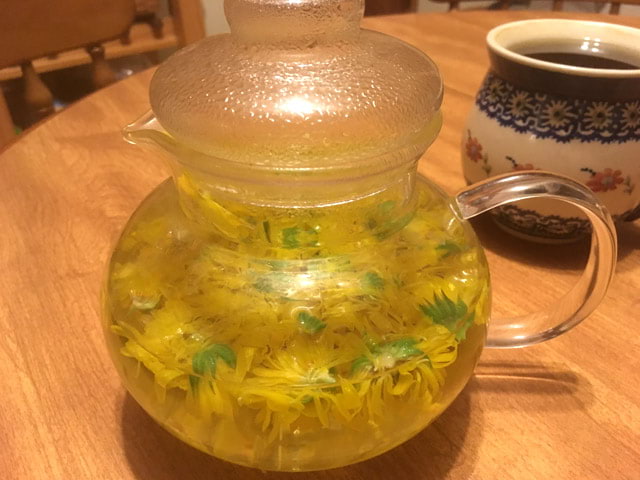
Calendula Salve
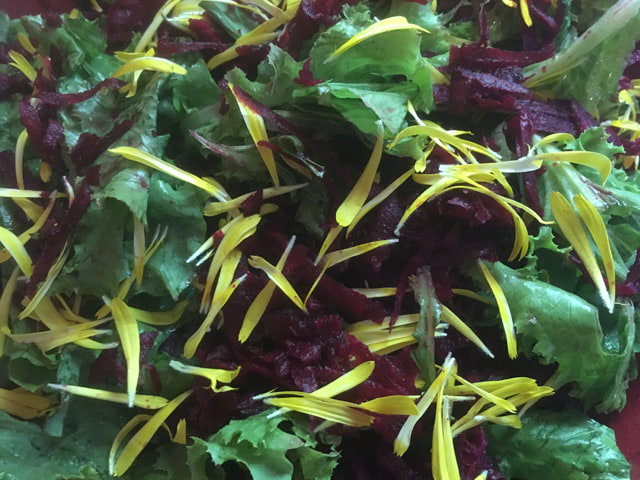
Calendula, Beet and Kale Salad
This salad is as delicious and healthy, as it is beautiful. We enjoy this salad several times a week throughout the summer and it makes a great dish to carry to a summer potluck. We took it to a friend's house last week and the Calendula petals on the salad inspired some wonderful conversation. Yes, we can eat lots of the flowers and weeds that grow around us and they are good for us in so many ways, too!When your garden is thriving in mid July with ample kale, Calendula and beets, try this recipe out for its delicious flavor and for its healthy benefits of vitamins and antioxidants. And, if you don't grow kale, beets and Calendula, look for the ingredients at your local Farmer's Market. Your local farmers and herbalists will be happy to share their goodness with you.
Ingredients:
Bunch of Freshly Picked Kale (cut into small pieces)
2-3 Beets (peeled and shredded)
6-8 Calendula flowers (petals from freshly picked flowers)
1/2 cup Walnuts (toasted and chopped)
Goat Cheese (if desired)
Balsamic Vinegar and high quality Extra Virgen Olive Oil
To make Salad: Clean and cut Kale leaves. Peel and shred beets. Chop and toast walnuts in iron skillet for 6 - 8 minutes on low to medium heat. Mix kale and beets together in large bowl. Sprinkle olive oil and balsamic vinegar and blend with kale mixture. Sprinkle toasted walnuts on salad and adorn with Calendula petals and Goat cheese as desired. Enjoy!
Comfrey (Symphytum officinale, Symphytum uplandica x, Symphytum peregrinum)
Comfrey Infused Oil (for external application)
Comfrey infused oil can be applied to bruises, skin abrasions, burns, aches and pains, site of broken bones and sprains. The oil helps to soften the skin so that the herbal qualities of Comfrey can penetrate the area and help to relieve pain caused by injuries.Organic oil of choice (olive, almond, apricot, etc)
Freshly cut Organic Comfrey root, stems and/or leaves (wilted)
(can use dried Comfrey leaves and stems)
Option 1: Harvest stems and leaves and hang in small bundles or spread on drying screens to wilt/dry (12 hours- 3 days), as they are quite moist and may mold if you do not dry them a little before infusing them in oil. (Using a fan and/or heater to help circulate air will help). Now, chop or cut herb and place herb in a clean jar with organic olive oil to completely cover (having a 1/4 inch of oil covering herb on top). Allow a little room at top of jar and check after 12 hours to see if you need to top off the oil a little (making sure all herb is immersed). Store in dark place or place in brown paper bag. Try to swirl infuses oil daily, infusing positive energy. After 4-6 weeks, strain Comfrey leaves and stems from oil. Let strained oil sit for one day and check to make sure there is no water present at bottom of jar. Decant the oil from the water if water separates and is present at bottom of jar. (Some of our chickens love to feast on this discarded oily herb when it is mixed with other leftover food scraps).
Option 2: Use an old crock pot with a low setting. Place chopped or cut leaves/stems in oil. Heat oil on lowest setting in crock pot for 2-4 hours (not above 110-120 degrees F) and strain. Keep an eye on the temperature of the oil, as oil will lose its healing properties if heated above 110- 120 degrees. Let strained oil sit for one day and check to make sure there is no water present at bottom of jar. Decant the oil from the water if it is present at bottom of jar.
Enjoy oil as a healing remedy on its own or include it with other oils and/or with beeswax for a healing salve.
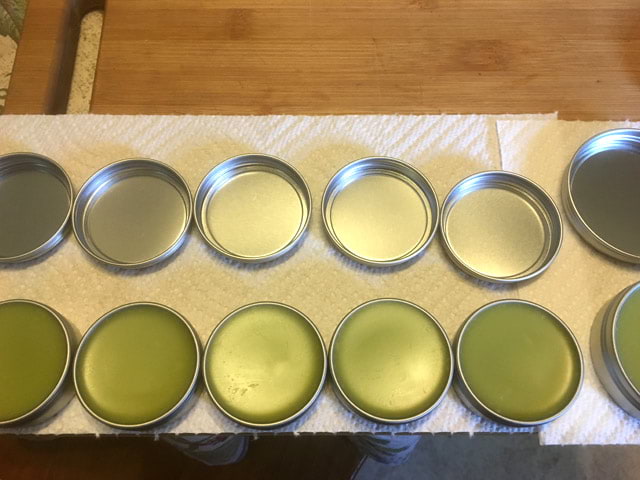
Comfrey Salve
Comfrey Salve
This salve is very soothing and healing to skin irritations, bruises, sprains and rashes. It can also be used on the wound before adding a compress and/ or fomentation to help soften skin, making it easier to penetrate into wounded area with the healing allantoin from the Comfrey.1 cup Comfrey leaf and stem (or root) (wilted or dried) infused oil (this can be made with other herbs as well, such as Plantain, Calendula, Chickweed, Violet)
1/4 cup Clean Grated Beeswax (use more if you like a very firm salve)
Optional: add 1/2 teaspoon Vitamin E oil as additional preservative
First, prepare an herb infused oil.
To make the salve, add 1/4 cup grated beeswax to double boiler. If using pyrex or mason jar, place in pot of gently boiling water to melt. Meanwhile, pour in one cup of herbal infused oils to heat proof jar, 2-cup measuring pyrex container or double boiler with beeswax. When beeswax is melted, remove jar of solution from heat and pour into small jars or tins. It will thicken and harden as it cools. If the consistency is not to your liking, simply remelt salve and make adjustments (more beeswax for a firmer salve or more oil for a softer salve).
Apply as needed (3-4 times a day) and feel nature's healing powers!
Comfrey Compress or Fomentation
This is an external application of herbs to help treat or alleviate swellings, aches and pains, bruising, sprains and the healing of broken bones. Hot (and/or alternating with cold) fomentations can help to stimulate the circulation of blood or lymph in the wounded area and allow healing qualities of the Comfrey to enter slowly through skin.Fresh or Dried Comfrey Root, and/or Leaves and Stems
Clean moisture absorbent cloth or towel
Hot pad or hot water bottle (optional)
Make a comfrey tea of two to three Tablespoons dried Comfrey with one cup just boiled water. Steep for 15 minutes or longer and strain. Place clean cloth in tea and wring out. Apply to desired area. For a hot fomentation, place a dry cloth over hot tea cloth and cover with heating pad or hot bottle. The heat will help relax achiness. This can be alternated with cold compresses to increase circulation to area. It can also be combined with a warm comfrey poultice and Comfrey oil for even more herbal healing.
Dandelion (Taraxicum officinale)
Dandelion Flower Cookies
These delicious cookies are sugar free, not too sweet and can be gluten free. Their only drawback is that there are less flowers for the honeybees and other pollinators. Makes approximately four dozen.1 cup coconut oil
1 cup honey
4 eggs
2-3 teaspoons vanilla extract
2 cups organic unbleached wheat or oat flour (can mix in a little ground flaxseed)
2 cups quick organic oats
3/4 - 1 cup dandelion petals (remove green base)
1 cup Chopped walnuts (optional)
1. Preheat the oven to 375 degrees F.
2. Blend the honey, coconut oil, and vanilla.
3. Beat eggs and mix into oil mixture.
4. Stir in the flour, flax, oatmeal, and dandelion petals. Add nuts if using them.
5. Drop the batter by tablespoonfuls onto an oiled cookie sheet.
6. Bake for 10-12 minutes.
7. Remove cookies from baking sheet and cool.
8. Enjoy!
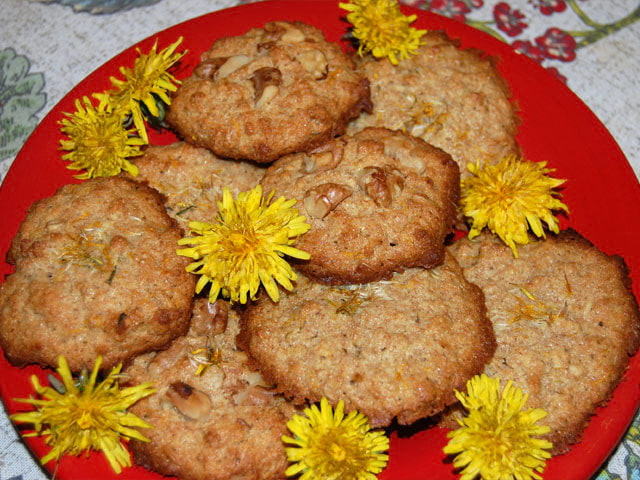
Dandelion Cookies
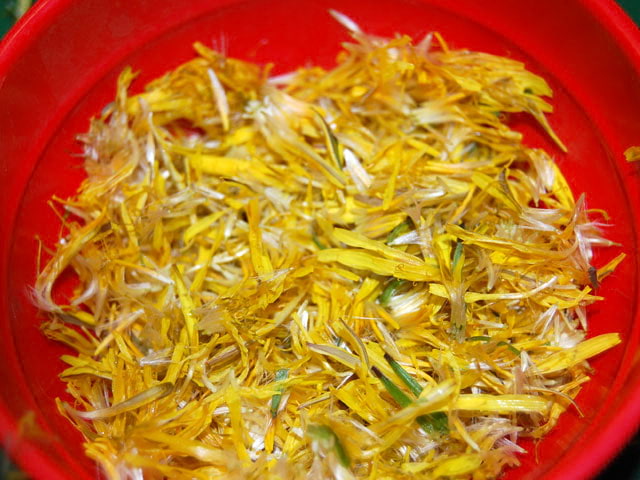
Dandelion Petals
Dandelion Wine
This wine is like harvesting the sunshine to be enjoyed during the cold winter months on special occasions.3 quarts fresh dandelion blossoms with green base removed
1 gallon filtered water
2 organic oranges (zested and thinly sliced)
1 organic lemon (zested and thinly sliced)
3 pounds organic cane sugar
1 package wine yeast
1 pound organic golden raisins (optional)
1. Harvest the dandelion blossoms when they are fully open on a sunny day, removing the green base.
2. Boil water and pour over the blossoms in a large pot. Cover and let steep for three to four days.
3. After three to fours days, zest the lemon and oranges and thinly slice them. Add the orange and lemon zest to the flower water mixture and bring to a boil. Remove from heat, strain out solids, and dissolve sugar into hot, strained mixture and let it cool.
4. Add the orange and lemon slices, yeast, and raisins to the cooled liquid. Place flower water mixture into a big ceramic pot or crock pot and cover with a clean tea towel or cheese cloth held in place by a rubberband or a loose fitting lid. Check to make sure gas is able to escape. Leave mixture to sit for 2-8 days, checking to monitor its progess.
5. The sugar flower water mixture is ready when it has stopped bubbling and the fermentation process is complete. It is important to ensure fermentation is complete before bottling. Strain the liquid through clean tea towels or cheese cloth and transfer to sterilized bottles. Cork or seal bottles and store in a cool, dark location for a minimum of 6-7 months.
6. Enjoy Dandelion's bright, cheery effect in the dark, cold days of winter.
Dandelion Root Decoction
This is a nice coffee substitute, stimulating the digestion but not the nerves.4 Tablespoons dried and roasted dandelion root
3 cups filtered water
1. Harvest roots in autumn.
2. Clean, slice and dry roots until almost crisp which can take up to 1- 2 weeks.
3. Roast dried roots in oven until dark brown (usually around 45 minutes - 2 hours at 250 -300F.
4. Cool and store in clean and dry glass jar until ready for use.
5. Prepare as a decoction, simmering chopped roots in water for 30- 60 minutes or until volume has reduced to half. Strain decoction. Add warm milk/cream and honey or maple syrup to taste. Enjoy!
Dandelion Green Salad
This is less bitter if mixed with other greens like violet leaves and flowers, spinach, chickweed and arugula.Harvest fresh clean dandelion flowers and leaves and stems (less bitter in early spring).
Add to other harvested spring greens of choice.
Chop and enjoy with a nice apple cider garlic ginger vinegar dressing or healthy salad dressing of choice.
Dandelion Stir Fried Brown Rice (4-6 Servings)
This is a delicious, quick and easy one dish meal if you have brown rice left over from a previous day. We make brown rice in very large batches with these meals in mind.2 onions (chopped)
1 cup dandelion blossoms (before they open)
1/2 cup dandelion greens (chopped)
1/2 cup Dandelion and/or Burdock root (cleaned and chopped)
4-6 cups cooked brown rice
4-6 eggs
Fresh green onion or chives (chopped) to sprinkle on top
1 - 2 Tablespoons Reduced sodium tamari or soy sauce
Cayenne powder to taste
Olive oil or sesame oil
1. Harvest dandelion blossoms, greens and Dandelion and/or Burdock root.
2. Saute chopped onion, chopped roots and dandelion greens in oil.
3. Add eggs and cook until done to desired consistency.
4. Stir in cooked rice and dandelion blossoms.
5. Mix in tamari and cayenne (adding more or less to taste).
6. Sprinkle top with thinly sliced green onion.
Enjoy!
Dandelion Flower Tea
Enjoy this tea to help as a mild pain reliever for headaches, menstrual cramps and other achiness.Harvest a handful of fresh dandelion flowers (two- four Tablespoons of loose petals)
Pour one to two cups of boiling water over flower petals.
Steep 15 minutes.
Strain and sweeten with honey as desired.
Sit and enjoy!
Enjoy!
Whole Plant Dandelion Vinegar
This highly nutritious vinegar will help stimulate the digestion and offer much needed vitamins and minerals if one is feeling depleted. Add a splash to steamed greens, raw greens, or drink it as a tonic mixed with a little honey and water.Dandelion Greens
Dandelion Root
Dandelion Stems and Flowers
Organic Apple Cider Vinegar
Garlic cloves (optional)
Horseradish root (optional)
Cayenne pepper (optional)
Burdock root (optional)
Turmeric powder (optional)
Ginger root (optional)
1. Harvest and clean dandelion, horseradish, and burdock.
2. Chop all roots, herbs and spices that are being used into small pieces and put in clean glass jar. OR go to number 6.
3. Pour apple cider vinegar to completely cover; filling jar.
4. Cap, label and store away at room temperature for 4-6 weeks.
5. Strain and keep in refridgerator to use as needed.
OR
6. Place all ingredients in liquid vitamixer and blend. Pour into clean jar and place in refridgerator.
7. Splash on steamed greens or fresh green salad.
Stinging Nettle (Urtica dioca)
Nettle Infusion (Urtica dioca)
(Very nourishing tonic for fatigue and allergies when taken daily for a few weeks)1 oz. dried nettle tops or leaves
1 quart boiling water
In heat proof quart jar, pour boiling water over nettle leaves and let infuse for 4-8 hours, or overnight. Strain and drink within 24-36 hours.
Chopped fresh Nettle tips and Lion's Mane mushrooms
Steamed Nettle tips with sauteed Lion's Mane mushrooms; topped with fresh Garlic Olive oil and Goat cheese
Steamed Nettle and Garlic
Basket of freshly picked Nettle tops (stems and leaves)Garlic cloves (crushed)
Sea Salt to taste
Olive oil
Bring pot of water to a boil. Rinse nettles if needed. Chop nettles and place in steamer or strainer with lid. Steam for 5 minutes or until soft and bright green. Remove from water bath and drizzle olive oil, freshly pressed garlic and salt to taste. This is a delicious on it own with eggs and goat cheese or as a side to any meal. This is also the base for many other dishes.
Nettle Quiche (for 2 quiches)
2 previously prepared whole wheat crusts1 large Onion chopped
4-6 Garlic cloves
Basket of Nettle tops or leaves, cut in small pieces (2-3 cups)
Sun dried tomatoes, cut in slivers
Mushrooms (freshly harvested Oyster, Lion's Mane or Wine Cap, or whatever you have) tear, slice or cut (Rehydrate mushrooms if using them dried and pat dry)
8 oz Grated Cheese of your choice (we use combination of Gouda and Goat cheese)
12-14 eggs depending on size
1/2 cup good quality cream
Olive oil
Herbs of your choice (Cayenne, Basil, Oregano, Rosemary, Parsley)
Prepare whole wheat crust ahead of time. Preheat oven to 400 degrees F. Bake crusts for 8 minutes so that crust is partially cooked (and will not be soggy when adding egg and veggie mixture).
Saute onions in olive oil until transluscent. Add chopped nettles, garlic, mushrooms, and herbs. Cook until nettles are soft and wilted. Meanwhile beat eggs, and cream together in large bowl with spout. Grate cheese and sprinkle some on bottom of crusts. Spread nettle mixture in each crust. Pour egg mixture over nettles and sprinkle the rest of the cheese. Garnish with sun dried tomatoes and any other herbs.
Place quiches in oven at 400 degrees F for 10- 15 minutes and then lower temperature to 325 degrees F for another 20-30 minutes (until quiche has set). Let quiches rest for 10-15 minutes before slicing into them.
We serve this with Garlic-Herbed Potatoes and Vegetable- Herb Soup or a Green Salad of freshly picked in season greens:Arugula, Spinach, Dandelion, Violet, Plantain, and Lambs Quarter leaves. Yum!
Note: This can be made as a crustless quiche. Prepare in well oiled iron skillet following the directions above.
Easy Nettle and Potato Soup
Freshly picked Nettle tops (cleaned and chopped) 6cups12 medium potatoes (quartered)
2 onions or leeks (diced)
4 carrots chopped
4-6 Chopped Garlic cloves
Salt and pepper to taste
8 cups water or broth of your choice (can be a mixture of water and broth)
1-2 cups milk of your choice (or more if you like)
Olive oil
Herbs of your choice (parsley or chives)
Quarter potatoes and place in pot with 8 cups of water or broth. Bring to a boil and add nettles tops. When potatoes begin soften, lower heat and let simmer. Meanwhile, saute onions in olive oil until soft. Add carrots and garlic and cook for another few minutes. Now smash potatoes and nettles in the liquid with a potato masher, making a chunky, thick soup. Add the onion and carrot mixture and stir. Add milk or cream and season to taste. Let simmer for another 10-20 minutes with lid off.
Nettle Chai (1-2 servings)
We love this delicious and spicy herbal brew on a cold afternoon in spring or as a dessert on a blustery wintery evening! Even those who do not really like the taste of nettle will be delighted by this home brew.2 cups filtered water
1/2-1 cup organic whole milk or milk substitute
6-8 green pods (cracked)
5-6 organic cloves
1 inch piece of Cinnamon stick/bark
10-12 Black peppercorns
2-3 slices of fresh peeled ginger
3-4 heaping Tablespoons dried nettle leaves
Local Honey or cane sugar (optional) to taste
1/2 teaspoons black tea (optional)
Bring all ingredients (except milk, black tea and sweetener) to a boil in a non aluminum pot over medium heat. When this liquid comes to a boil, turn down heat and steep for 20-40 minutes with lid slightly ajar. Turn off heat and add black tea (if desired) to steep for five minutes. Add milk and bring solution to a gentle simmer to warm milk. Turn off heat. Pour tea through mesh strainer. This recipe makes one to two cups of Chai. Enjoy with loved ones or relish in some time to nurture yourself!
Elder (Sambucus canadensis and/or Sambucus nigra)
Elderberry Syrup (an all time favorite herbal remedy in our home)
2 cups dried elderberries2 quarts water
Raw wildflower honey
Optional: Fresh ginger, cinnamon
Place elderberries in filtered water and bring to a boil. Simmer for 45 minutes to an hour or until reduced by half in volume. Mash the berries to help bring out all the goodness. Cool a little and strain elderberry infusion into clean quart jars, leaving 1/3 - 1/2 space to add the raw honey to taste. We make this syrup with local and raw honey and elderberry infusion. Mix well and keep refrigerated. Take 2-3 Tablespoons of this syrup alone or in a little hot water at the first sign of infection. Continue taking 3-4 times a day until well.
We usually make this syrup in October as we prepare for the flu season. The syrup lasts at least 3 months (I am not sure because we finish it within that time). We often make a smaller batch in late January to keep us well for another few months. You could consider adding an infused elderberry/flower brandy or vodka to this syrup to help preserve it for longer and to enjoy the added benefits.
This can be included as a flu prevention by taking 1 tablespoon daily alone or in hot water as a tea. We also drink it as a cordial by adding a dropperful of Herbal Elderflower/berry infused brandy (tincture) to the Elderberry syrup with a little hot water. This is a delicious and nurturing way to end a winter evening and I highly recommend including this ritual as a daily practice to be well during the cold winter months. Note: When making this syrup, be sure to do it when you can air out your kitchen (and not before you have guests coming to stay), as the elderberries have a distinct odor that some people do not appreciate.
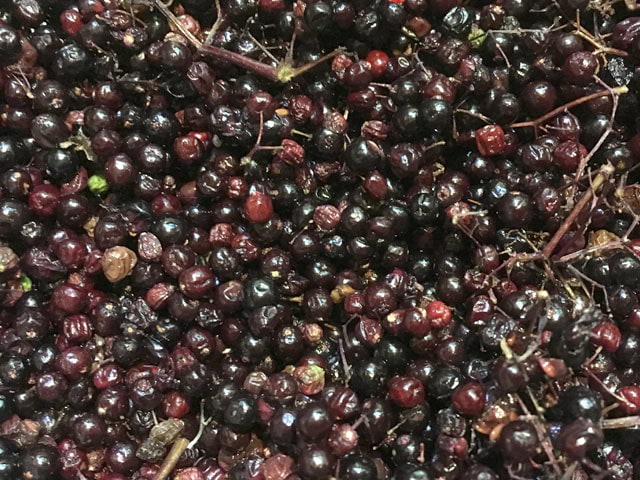
Elderberries
All Seasons Wellness Herbal Tea Blend
We prepare a house blend of herbs for seasonal wellness. The all seasons wellness herbal blend that we drink daily includes a mixture of holy basil, milky oat tops, calendula and Elderberries. I store this wellness blend in a large glass jar, on the kitchen counter, so it is very accessible and easy to include in a daily practice of tea time.Work with the herbs that you have and that grow around you; and experiment with combinations that you and your family enjoys. We usually start with a base blend of about three to four herbs at a time. We add or omit different herbs as needed to individual cups of tea, such as one teaspoon of sage or thyme to the seasonal blend to help with opening the nasal passages. For a sore throat we might add thyme and/or a decoction of licorice root. There are so many great herbal options to consider! (We also include slices of fresh ginger in our teas or as a lozenger when confronted with viral infections, upper respiratory discomfort and chills).
Basic Recipe for All Seasons Wellness Herbal Blend:
1 part dried Elderberries
1 part dried Holy Basil leaves
1 part dried Calendula flowers
1 part of Milky Oat Tops
Option #1 : Add or replace one part dried Thyme, Common Sage, Bee balm, or Hyssop (for sinus and throat care)
Option #2 : Add one part Echinacea root and flowers, (at onset of flu symptoms)
Option #3 : Add fresh slices of Ginger and Elderflower (especially if chilled and or feverish)
Make your herbal blend. Place 1 -2 Tablespoons of herbal blend per pint of just boiled filtered water. Cover and let herbal mixture steep for 30-45 minutes (depending on taste). Strain and drink 3-4 x /day if not feeling well or daily as a delicious seasonal tea for winter wellness at tea time.
Winter Wellness Elder Tea
1 part crushed Elderberries (dried)1 part Elderflower
1 part Lemon balm or Peppermint
1/2 part Yarrow flowers and leaves
Fresh Ginger slices to taste
Optional: Include 1 part Echinacea flowers, stems and roots for extra support
Filtered boiling water
Raw, local honey to taste (if desired)
Mix herbs. Place one teaspoon to one tablespoon of herbal blend in a teacup. Pour boiling water over herbs. Cover and let herbal mixture steep for 30-45 minutes. Strain and drink 3-4 x /day, until fever breaks or until feeling well. I usually make a quart of this at a time and then store it in an insulated flask to drink throughout the day.
This tea can be enjoyed as a preventative. Drink once a day or as a way to help heal when a full on infection has set in. It is nice to drink hot with a spoonful of raw and local honey.
Drink this tea at the first sign of infection (when you feel that tingly, cold sensation deep in the bones or notice a scratchy throat or feel feverish). If possible, take a warm bath after drinking the tea and rest, bundled up in several blankets to promote some heat and break into a sweat. Continue to drink the tea 3-4 x /day until well. Additionally, enjoy some Elderberry syrup or Elder tincture of flowers and berries for more herbal support.
Elder and Pine Sinus Relief Tea
1/4-1/2 c Elderberries (dried) decocted in one pint of water3-4 Tablespoons Marshmallow root (dried)
4-6 Tablespoons fresh Pine Needles (cut into small pieces)
Place Marshmallow root and Pine needles in a quart jar with cool filtered water for 6-8 hours, meanwhile decoct elderberries in boiling water and let simmer for 30-45 minutes. Strain mixtures and blend together. Warm when ready to serve.
This is a full flavored herbal tea, with the soothing/grounding qualities of the marshmallow root and the uplifting qualities of the pine. The elderberries seem to balance the other two herbs. Very nice!
Cold Care Herbal Remedy Tincture
1/2-1 part Yarrow flowers (and young aerial parts) tincture2 parts Elder Blossom tincture
3 parts Elderberry tincture (or syrup)
2-3 parts Echinacea root (and aerial parts if possible) tincture
Optional: Substitute the fresh Ginger tea for the hot filtered water (if feverish)
Raw and local honey (for sore throat)
This is a powerful herbal remedy for sinus infections and colds and at the first sign of infection. Mix the tinctures by dropperfuls or teaspoons/Tablespoons in the proportion that is suggested to make your Cold Care Herbal Remedy Mixture. Mix 2-3 dropperfuls of Cold Care Herbal Remedy into a cup of very hot filtered water (or hot Ginger Tea). Breathe deeply, inhaling the steam. Sip and savor and invite the healing to take place. Continue to drink the tea 3-4 x /day until starting to feel better, hopefully in 24-48 hours. Discontinue with Yarrow after fever has broken. Discontinue with Echinacea after 5-6 days. The Elderberry syrup would be safe to continue taking as a preventative in 1 tablespoon a day.
Oatstraw (Avena sativa)
Oatstraw Infusion
Oatstraw infusion is a very nourishing tonic for the nervous system, containing calcium, iron, magnesium, manganese, zinc, and B vitamins. Oatstraw infusion is especially nice for anyone who is fatigued, needing focused and calming energy, and for those who are healing from nerve damage or degenerative nerve diseases. Women who are pregnant and going through menopause may also benefit from oatstraw's soothing and nurturing qualities. Even those with a gluten intolerance have benefited from oatstraw without problems. Infusions are a Wise Woman approach to nourishment, passed on to me from Linda Conroy, Susan Weed, and Isla Burgess; and hopefully, they will also become a part of your nourishing traditions, too. See Herbal Allies for more discussion of Avena sativa.1 oz dried Oatstraw/milky oat tops
1 quart filtered water
In a large covered pot, bring oatstraw and filtered water to a boil for 5 minutes and then let sit (infuse) for 4-8 hours with stove off. OR In heat proof quart jar, pour filtered boiling water over oatstraw and let infuse for 4-8 hours, keeping the jar insulated. Strain and squeeze out all liquid, then compost the remaining herb. Drink at room temperature or cool it in the summer months. Keep infusion refrigerated and use within 36-48 hours. Enjoy one to two cups a day or as needed.
We alternate infusions each day, working with other herbs such as stinging nettle, red clover, red raspberry leaves, comfrey leaves, mullein leaves, and rose hips, but oatstraw and stinging nettle tend to be favored as they are more available to us and we have allied strongly with them in the last several years.
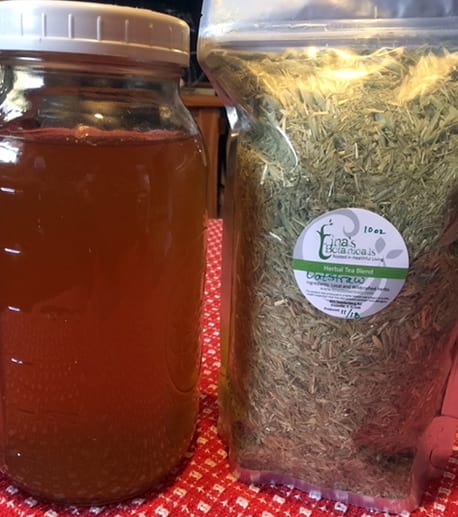
Oatstraw Infusion
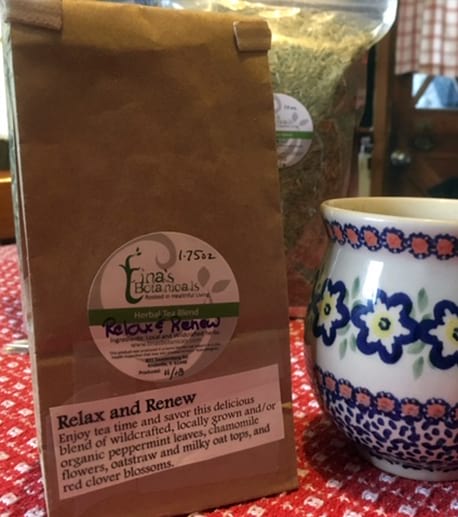
Relax Renew Oatstraw Herbal Tea
Relax & Renew Herbal Tea Blend
I invite you to tea time... a time to nourish our hearts, minds and bodies. Cultivate a practice of slowing down and offering yourself and others a ritual of rest and delicious teas. Choose single herbs or blends of wildcrafted, locally grown and/or organic herbs. Let a cup of tea help you to pause and savor the beauty in life!This blend has been a favorite in our home, at herbal workshops, and at the Galesburg Farmer's Market!
1 part dried Oatstraw/milky oat tops
1 part dried Peppermint leaves (Mentha sp.)
1 part dried Chamomile flowers (Matricaria recutita)
1 part dried Red Clover blossoms (Trifolium pratense)
Place one teaspoon to one tablespoon of herbal blend in one cup of just boiled water and steep 10- 15 minutes (depending on taste). Strain and enjoy! We love this alone or with a little local raw honey or fresh ginger in the afternoon or in the evening before going to bed.
I often include a restorative yoga pose before or after sipping this tea in the afternoon. To receive the full effects of the Relax/Renew tea, I highly recommend an afternoon savasana of 15- 25 minutes. Prop the head and neck on a folded blanket, with forehead slightly elevated above the chin. Bend the knees and prop under them with a bolster or folded blanket OR place legs up on the wall or on a chair. Refer to the Yoga section on website for a picture. Slow the breath, close the eyes, and clear the mind as you invite a deep sense of relaxation and renewal to your heart, mind, and body.
Relaxation Herbal Tea Blend OR Herbal Footbath
Oatstraw pairs well with a lot of other herbs for relaxation. Choose single herbs or blends of wildcrafted, locally grown and/or organic herbs to mix with the oatstraw. The blend below is quite calming. Let this cup of tea help you to fully relax, breathe deeply, and settle in for the evening. This same herbal tea blend can be made as a tea and added to a small tub or basin of hot water for a delightful foot bath before bed, another great way to induce a good night's sleep. For even more pampering, finish with a warmed herbal infused oil foot massage... sounds like the makings to a very relaxing evening!1 part dried Oatstraw/milky oat tops (this could be made as an infusion first) and mixed with one or all of the following herbs:
1 part dried Lemon balm leaves (Melissa officinalis)
1 part dried Chamomile flowers (Matricaria recutita)
1/2 part dried Lavender flowers (Lavendula angustifolia) or Rose petals (Rosa Rugosa)
For even more relaxation: include 1 part Hops (Humulus lupulus) or decocted Valerian root (Valeriana officinalis)
Place one teaspoon to one tablespoon of herbal blend in one cup of just boiled water and steep 5 - 10 minutes (depending on taste). Strain and enjoy with or without raw local honey! We usually drink this late in the evening, as it can induce a sleepy state.
Prenatal Mama Herbal Blend
This is a nutritious and calming blend to include during pregnancy. Raspberry leaves are often used in pregnancy to tone and prepare the uterus for birth and to help prevent post partum hemorrhage. The oats nourish and relax the mama with bioavailable calcium at a most critical time. This can be made as a tea, but it is even more nutritious as a long steeped infusion.For Infusion: 1/2 oz. dried organic oatstraw (with milky oat tops) 1/2 oz dried organic red raspberry leaves (Rubus idaeus); 1 quart filtered water
In a large covered pot, bring oatstraw and water to a boil for 5 minutes. Turn off stove. Add raspberry leaves and stir to immerse all of the herb. Let sit (infuse) for 4-8 hours, keeping pot insulated with a towel wrapped around it. Strain and squeeze out any residual liquid, then compost the remaining herb. Drink at room temperature or cool it in the summer. Keep infusion refrigerated and use within 36-48 hours. Enjoy one to two cups a day as needed. This can also be frozen as ice cubes with a little honey as a refreshing treat during hot summer days or taken as ice chips during labor.
For tea: 1 teaspoon - 1 Tablespoon of equally blended dried Oatstraw/milky oat tops and Raspberry leaves (Rubus idaeus). Place one teaspoon to one tablespoon of herbal blend in one cup of just boiled water and steep 10 - 15 minutes (depending on taste). Strain and enjoy! If there are any feelings of nausea, add fresh or dried ginger and/ or peppermint to the tea blend.
Oatstraw & Deep Nourishment Herbal Infusion
Deep nourishment herbal infusion is a combination of nutritive herbs that can help to support the nervous system, endocrine system, reproductive system and muscular system as it contains calcium, iron, magnesium, manganese, zinc, potassium, silica, folic acid, and B vitamins. This infusion is especially nice for anyone who is nutritionally depleted or fatigued. Oatstraw pairs well with a lot of other herbs for deep nourishment and it balances many of them out by offering a more mellow taste and moisturizing effect to the herbal blend. Choose one or all of the following wildcrafted, locally grown, and/or organic herbs to blend with the oatstraw. The amounts of herbs can vary according to taste and the reason you have chosen them, so that you use approximately one ounce of blended herb to one quart of filtered water.1 oz dried organic Oatstraw (with milky oat tops)
1/2 oz dried Stinging Nettle (Urtica dioica)
1/4 oz dried Red Raspberry leaves (Rubus ideaus)
1/4 oz part dried Red Clover blossoms (Trifolium pratense)or Comfrey leaves (Symphytum officinale), depending on the intention for where you are directing the healing
1/8 oz Horsetail (Equisetum arvense)
1/2 gallon filtered water
In a large covered pot, bring oatstraw and water to a boil for 5 minutes. Turn off stove and then add the remaining herbs. Stir and let sit (infuse) for 4-8 hours, keeping the pot wrapped in a towel. Strain and squeeze out all liquid, then compost the remaining herb. Drink at room temperature or cool it in the summer months. Keep infusion refrigerated and use within 36-48 hours. Nourish with one to two cups a day or as needed.
Oatmeal Facial Scrub
This is a simple and natural facial scrub that is easy to make, easy to use, and leaves the skin feeling extremely refreshed and invigorated. It is gentle enough to use several times a week, depending on the condition of your skin. As we age, our skin is a little thinner and often dryer, so adjust your skincare routine and ingredients accordingly, using more fatty liquids for dry skin (whole milk) or less fatty liquids for oily skin (skim milk or filtered water).2 Tablespoons ground organic oats
1/2 Tablespoon raw organic sunflower seeds
1- 2 Tablespoons liquid (filtered water mixed with choice of organic milk)
This should be enough for one week, if only being used on the face.
Optional: herbal infused teas to replace water, such as lavender, elder flower, calendula, & rose
Grind oats and sunflower seeds. (I use an old cleaned coffee bean grinder and store the dry oat scrub in a 4 oz glass jar with lid away from light and moisture). In another small bowl, add 1/2 Tablespoon liquid mixture to 1 Tablespoon of dry oat scrub powder to form a paste. Add more or less liquid to your desired preference. It usually thickens after one or two minutes. Apply the oat scrub paste to the face and neck and gently massage with loving thoughts, to nourish, clean, and exfoliate. (I can't help myself from licking my lips and tasting the sweetness of this scrub, dreaming of other yummy recipes). Rinse with warm water and apply a good quality, natural facial moisturizing cream (see moisturizers and skin care products on website).
Note: This could be made as an oat body scrub by increasing the amount of the dry oat scrub powder and increasing the amount of liquid. Make an herbal oat scrub by adding herbal infused liquid to the oat powder mixture.
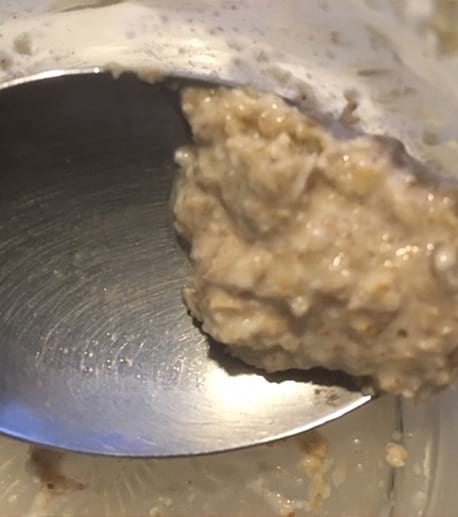
Oatstraw Infusion
Soothing Oats & Herbal Bath
Oatmeal steeped in hot water and added to the bath is a long time remedy for soothing all types of skin irritations. I remember my mother preparing this warm bath when I was a young child with the chicken pox, to soothe the itching and bring some relief to my younger sister and I (we didn't want to get out of the tub that night!).1 oz dried Oatstraw
1/2 cup organic oats
2 quarts filtered water
handful of your favorite herbs: lavender flowers, calendula flowers, chamomile flowers, & rose
In a large covered pot, bring oatstraw and water to a boil for 5 minutes. Let sit for one hour. Heat the mixture again until boiling. Turn off heat. Add the herbs and oats, then steep an additional 30 minutes - 60 minutes. Strain and squeeze out all liquid, composting the remaining herb. Add this mixture to your hot bath water and soothe your worries away, as you soak in this herbal bath for 20-30 minutes.
Warm herbal baths are wonderful for nurturing the body and soul, providing the time for yourself to fully relax and receive the penetrating warmth and essence of the herbs and the softening and soothing effects of the oats on your skin and nerves. Adding other rituals to the self care routine, like good quality candles, hot herbal tea, and a restorative pose after you are finished with your bath, can also be deeply satisfying.
To purchase local herbal products, visit the Products page on the website and contact tinasbotanicals.com to make arrangements. Herbal products and tea blends can be found locally for purchase at Dahinda General Store in Dahinda, Illinois and at the Galesburg Farmer's Market, Galesburg, Illinois.
Mullein (Verbascum thapsus)
Mullein Tea and Long Steeped Mullein Infusion
This tea has long been a healing remedy for respiratory complaints in many parts of the world. We have certainly benefited from it in our home, ever since I came to know this plant more intimately and have work with it where we live. It breaks up congestion in the bronchioles and helps stimulate movement of fluids and expectoration, while reducing inflammation and soreness throughout the respiratory system. See Herbal Allies for more information on Mullein.Mullein tea: 1-2 teaspoons ground dried Mullein leaf and/or flowers
1 cup filtered boiling water
Pour boiling water over herb and steep for 10 - 15 minutes. Strain through a coffee filter to ensure that the throat does not get irritated by the little hairs on the leaves. This tea be taken three times a day, or as needed. I am not aware of any contraindications with this herb.
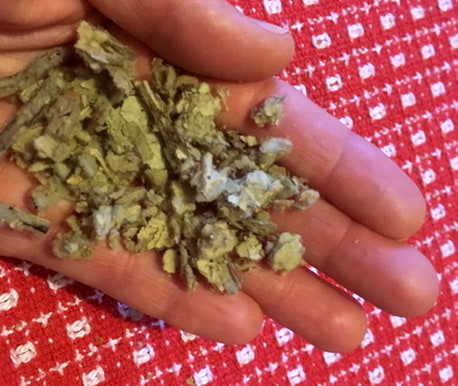
Dried Mullein
Mullein Infusion
1 oz dried Mullein leaves1 quart filtered water
In a heat proof quart jar, pour filtered boiling water over mullein leaves, and wait a few minutes as the leaves really soak up the liquid. Add more water to fill the jar and secure the lid in place. Let the mixture infuse for 4-8 hours or overnight, keeping the jar wrapped in a kitchen towel for a little insulation. Strain the infusion through a coffee filter place inside another strainer, and squeeze out all liquid, composting the remaining herb. We enjoy drinking this warmed with a little milk and maple syrup; making it a very delicious respiratory remedy before bed or to replace morning coffee. (The addition of milk and maple syrup was suggested to me by Linda Conroy during my herbal apprenticeship with her, a delicious suggestion, especially if you have local maple syrup). Keep any remaining infusion refrigerated and use within 48 hours. Enjoy one to two cups a day or as needed.
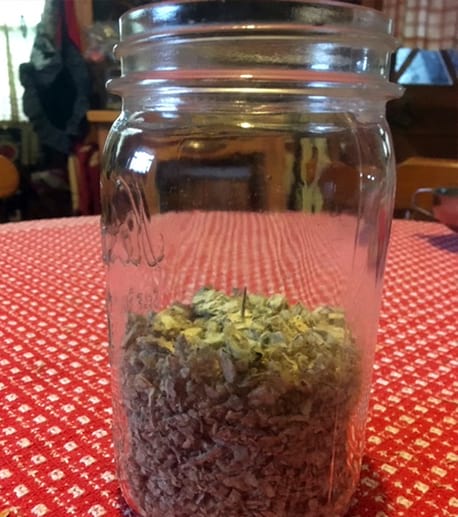
Dried Mullein in Jar
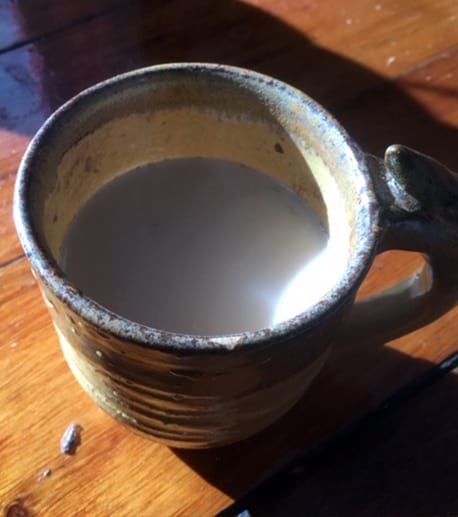
Mullein Infusion with Milk and Maple Syrup
Mullein Flower Oil
Mullein flowers are striking as they emerge over many days on the tall stalks of the Mullein plant from June through September. The flowers have a long history of use as an effective treatment as an infused oil for ear infections that accompany a cold or upper respiratory infection. A few drops of the warmed oil can be given in both ears to help ease pain. We have found that it is even more effective when combined with a fresh strained garlic infused oil (while at the same time, taking echinacea tincture internally, to help support the immune system).Mullein infused oil can also be use topically to relieve pain and can even be massaged into the temples or the forehead and around the sinuses to help ease sinus congestion. Matthew Wood (1997) suggests that it can be used in cases of neuralgia and has an affinity to the nervous system.
Making Mullein Flower Oil
Dry Mullein flowers
Organic olive oil
Clean, dry, glass jar with tight fitting lid (4 -16 oz jar is sufficient for the family herbalist)
Dark colored bottle for strained infused oil
Strainer
Cheese cloth or tea towel
Collect mullein flowers on a dry day; (preferably after three consecutive, dry days). If the flowers are too moist, the oil may develop mold.
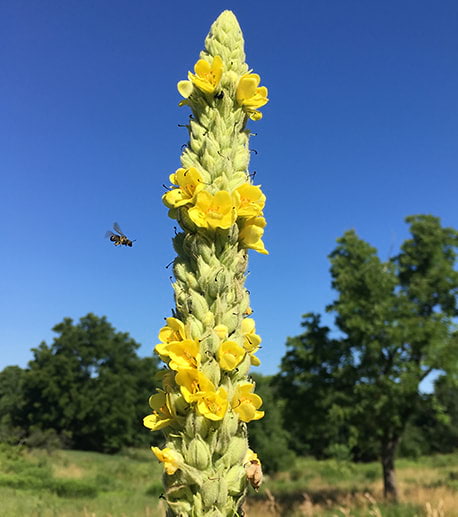
Mullein Flowers
Strain the infused oil through a small strainer lined with cheese cloth or an old tea towel and squeeze or press through strainer. Let the infused oil sit for one day and then decant and filter again if necessary. Store the infused oil in a dark colored bottle with a tight fitting lid and label with contents and date. Most infused oils have a shelf life of one year if kept in a cool and dark place. Oils can be used alone or made into a salve, which usually have a longer shelf life due to the preservative effect of the beeswax.
Mullein Flower Salve
This topical salve offers the delightful qualities of these beautiful flowers into an herbal remedy that works well with therapeutic touch. This salve is inspired by Rosemary Galdstar (2012), with the addition of lavender flowers which I find to give it a more sensual healing experience. Gently massage a little dab of this salve into areas of swelling or glandular and lymphatic congestion as often as needed. Apply the salve with light strokes toward the heart, setting the intention to move and dissolve the built up congestion. This herbal blend could be made into a hot tea, as well, for even more support. I believe that we often benefit from a combined effort of more than one remedy or approach to bring nurturing and healing to our whole selves.A gentle yoga practice would be an excellent addition to your daily routine if you have lymphatic and glandular congestion. And I love inversions, like viparita karani if there is swelling in the legs. Try placing legs up the wall and elevating under the sacrum with a yoga block or bolster for 10 - 25 minutes a day, to offer the body and mind a time to relax, possibly preventing and/or reversing other potential health issues, and letting lymph and blood shift their flow of movement.
To make the salve
1/4 cup +2 Tablespoons mixture of Mullein flowers and leaves infused in oil and strained
1/4 cup Calendula flowers (Calendula officinalis) infused in oil (strained)
1/4 cup Red clover blossoms (Trifolium pratense) infused in oil (strained)
Optional: add 1-2 Tablespoons infused lavender flower oil for its relaxing effects
1/4 cup Clean Grated Beeswax (use more if you like a very firm salve)
Optional: add 1/2 teaspoon Vitamin E oil as additional preservative
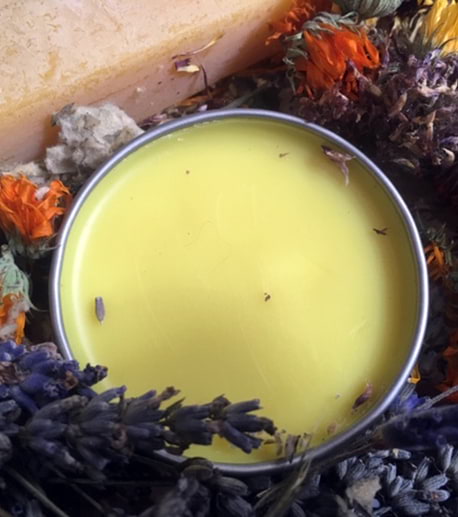
Mullein Salve
Pour 1/4 cup grated beeswax in a pyrex measuring cup (I use a 2 cup pyrex measuring cup, placing the handle out of the water bath so that it isn't as hot) or use a pint mason jar. Place container of beeswax into the pot of gently boiling water to melt. When beeswax is melted, pour in the different herbal infused oils with the beeswax. When beeswax and oils are fully melted, remove it from heat using an oven mit and pour into small jars or tins. It will thicken and harden as it cools. If the consistency is not to your liking, simply remelt salve and make adjustments (more beeswax for a firmer salve or more oil for a softer salve).
This recipe makes approximately eight ounces of salve. Store in cool place. Feel nurtured and embraced by nature's healing powers!
Mullein Steam Therapy for Sinuses
Juliette de Bairacli Levy (1997) gives very practical and personal accounts of how to work with herbs. This is one of her recipes that I have modified a bit, with the addition of the eucalyptus leaves and using a large pot instead of a kettle. I especially like it for relieving sinus pressure and congestion. She says that it works well for asthma and hayfever, as well.To make the Mullein steam:
Pot of boiling water with lid
Tablespoon or handful of dried mullein
Optional: Add a pinch of crumbled eucalyptus leaves or thyme to boiled water
Bring two to three quarts of water to boil. Turn off heat. Add the herbs and cover the pot for 3-5 minutes. Drape a towel around head and pot to create a vapor cocoon, so the steam does not escape and being careful not to burn yourself. Inhale the steam of boiling water with mullein for five to ten minutes.Take deep breaths with the eyes closed for as long as is comfortable and begin to feel the opening of the sinuses and movement of stuck congestion. I recommend the mullein steam therapy in addition to drinking the mullein tea and/or overnight infusion, as these remedies work well together.